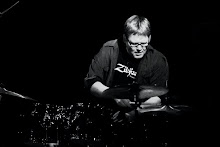This will be an intermittent series in which I look at all the components of the modern drum set individually. Now, many who know me will recall I often rant that the drum set should be viewed as one instrument, It is also true it is an instrument made of many instruments that stand alone as well.
I'll start with the Bass Drum. ( Don't you DARE call it the "K" word around here!) Although the bass drum can be tuned many different ways, it is the lowest pitch we're playing. It, along with the snare drum, are the parts of the drum set that harken back the most to their military origins. Playing four beats to the bar with the bass drum is a sound that permeates much of North American modern music, whether it's the pounding of Disco or Blues shuffles or the light feathering in a Jazz trio.
The Bass Drum is a marker. It's low pitch helps us stop and reset the music. If we think the band is lost, we play bass drum on beat one. Often, inexperienced drummers ( like yours truly not so long ago ) will play beat one with the Bass Drum ( especially in a Jazz setting ) so often, it will feel like the tune is only one or two bars long! Playing Bass Drum on beat one of every bar is one of the many "security blankets" we have to let go of as we free up our playing.
There's many ways this fascinating ways the instrument can sound too. From Elvin Jones' wide open ringy 18" drum.....
....to Steve Gadd's much bigger drum but much more muffled tone.
Or Jack DeJohnette's middle ground between the two...
Finally, I think of the modern drum set as having two major "sections", namely drums and cymbals. The drums give me images of earth. They are very grounded and grounding. The Bass Drum is especially earthbound. I find it interesting that the Bass Drum is the only part of the drum set where a major part of the instrument itself, and not a stand, is touching the ground. What's more it's played with our foot. When the music needs it, we are literally "putting our foot down" to correct things. So, next time you're playing your drums, give some thought to our low-pitched earthy friend and how it fits into your music.
...until next time....
Monday, November 20, 2017
Subscribe to:
Post Comments (Atom)

No comments:
Post a Comment